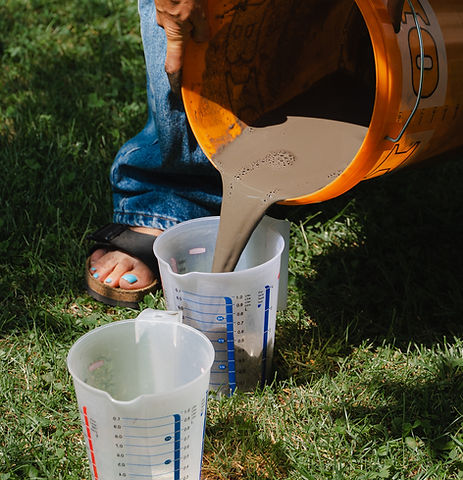Brittlestars in Piran Aquarium, Piran, Slovenia
Marine sediment species samples in N.I.B. Piran Station, Slovenia








Sediment Lab
A research-based artist project in Koper, Slovenia, explored the reuse of marine sediment—an abundant byproduct of port maintenance—as a biomaterial for sustainable design and shared the best recipes through hands-on, educational workshops.
The project responds to the ecological and logistical challenges posed by sediment accumulation from port area dredging, focused on transforming marine sediment into easily locally processed biomaterials for the home, and educating port residents about the marine organisms that inhabit these marine sediment ecosystems .

M.S.P.f.K. Marine Sediment Paint from Koper Bay

Marine Sediment Tiles
A key component of the project was an investigation of local benthic ecosystems—complex communities of organisms living within the sediment. The biogenic structures and marine "homes" that these organisms create with the sediment inspired the focus on using the sediment for applications within our terrestrial homes .These sediment ecosystems also informed the design of the projects elements and were a special focus of the workshop activities, serving as a powerful educational and conceptual tool.
The port of Koper is part of the northern Adriatic Sea, an environment of shallow waters, soft-bottom habitats, and complex ecological interactions. The seafloor sediment hosts entire communities of organisms including polychaete worms, burrowing shrimp, and other invertebrates.
One of the most crucial ecological functions in benthic sediment ecosystems is bioturbation: the physical reworking of sediment by organisms. Polychaete worms, for example, burrow, feed, and move vertically and horizontally, shifting sediments, creating burrows and tunnels transporting oxygen and deeper into layers otherwise depleted and processing detritus and organic matter.
These processes are not just internal—through benthic–pelagic coupling, the sediment ecosystem influences the overlying water column. Recycled nutrients and dissolved compounds support primary production and feed upward in the food web.

Marine sediment species in Piran Aquarium of local marine species, Piran, Slovenia

Shells from past dredging in former marine sediment disposal site Pokopališče školjk Ankaran, Slovenia.

Marine sediment species samples in N.I.B. Piran Station, Slovenia

Marine sediment species samples in N.I.B. Piran Station, Slovenia
Through experimenting with natural additives and different curing and shaping techniques , drawing inspiration from traditional craft as well as biogenic processes, we developed two sediment-based biomaterial recipes:
Sediment Tiles – compacted forms using binders and natural stabilizers with embossed and protruding forms inspired by seafloor structures.
Sediment Paint – a fine mixture that can be applied as a natural pigment on walls or surfaces, with subtle hues reflecting the mineral content of the port’s sediment.

Powdering, dried and cleaned marine sediment for use in material experiments

Marine Sediment Tiles using albumen, casein and plant gums

Marine Sediment Tiles using albumen, casein and plant gums

Marine Sediment Tiles using albumen, casein and plant gums

Marine Sediment Tiles using albumen, casein and plant gums
Sediment Lab public workshops were designed with a focus on skill-sharing and hands-on learning. Participants were introduced to the marine sediment ecosystems of Koper Bay and gained knowledge on the subject of biomaterials and their applications in human homes, they learned to work with the sediment-based mixtures . In the second part of the workshops participants mixed and produced their own sediment based cast tiles and sediment based earth paint for interior use taking them home to use. An archive of the various colour hues of sediment paint that the participants created was kept by them each painting a cutout symbol with their colour hue.
The outcomes demonstrate how discarded materials can be reimagined to create new natural products using low-impact fabrication processes.




Sediment Lab Workshops in HEKA Lab, Koper. Photo credit: Michela Colorito
Workshops took place in Pina's Heka Lab, Koper in May 2025 inviting art students and the general public on three separate occasions.
In June 2025 they were offered for family groups in Villa Arson, Nice as part of Porous: Ports as interspecies dwellings, organised by TBA21-Academy and curated by Maria Montero-Sierra.

Sediment Lab Workshops in HEKA Lab, Koper. Photo credit: Michela Colorito


Sediment Lab Workshops in HEKA Lab, Koper. Photo credit: Michela Colorito


Sediment Lab Workshops in Villa Arson, Nice. Photo credit: Claudia Goletto
To make your own natural, toxic free wall paint that is sustainable, economic, breathable and durable, download the Sediment Lab Paint recipe pdf.
You can use locally sourced clay soils from your area instead of marine sediment, adjusting the recipe volumes as you experiment.

Sediment Lab Workshops in Villa Arson, Nice. Photo credit: Claudia Goletto
The residency was funded by STARTS4waterII, with the support of the Marine Biology Station Piran (NIB) and the Port of Koper. STARTS4waterII is co-funded by the European Union under the STARTS – Science, Technology and Arts initiative of DG CNECT (Grant Agreement No. LC-02629312).


Digital Design: Christos Fousekis
Graphic Design: Christos Kotsinis
Production Assistance: Harut Marangozyan, Sunny Rakhul Choudkhuri
Many thanks to:
Vesna Flander Putrle
Neza Leban
Valentina Pitacco
Franka Cepak
Ana Markezic
Maria Montero Sierra
Benedetta D'Ettorre